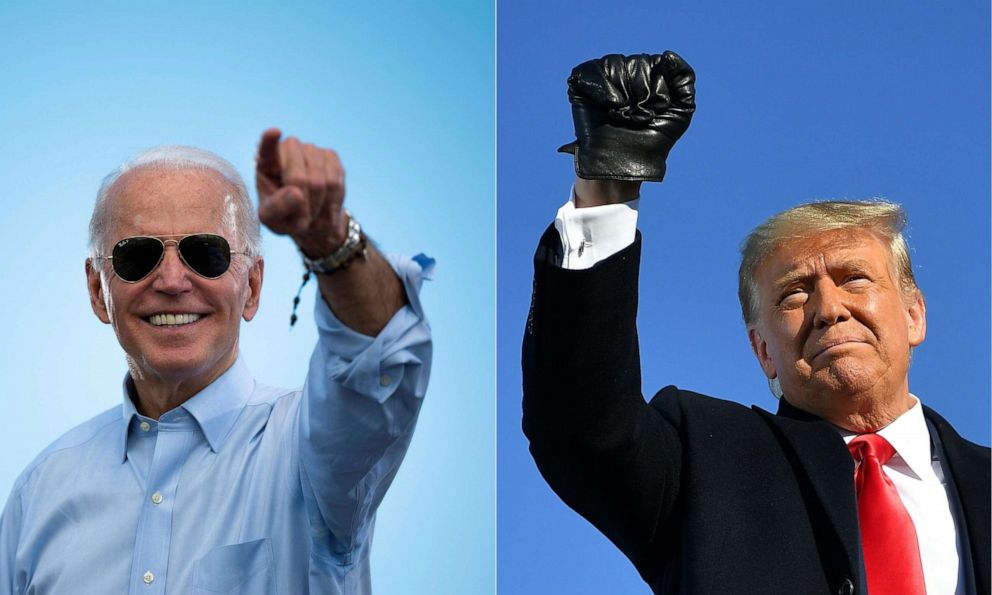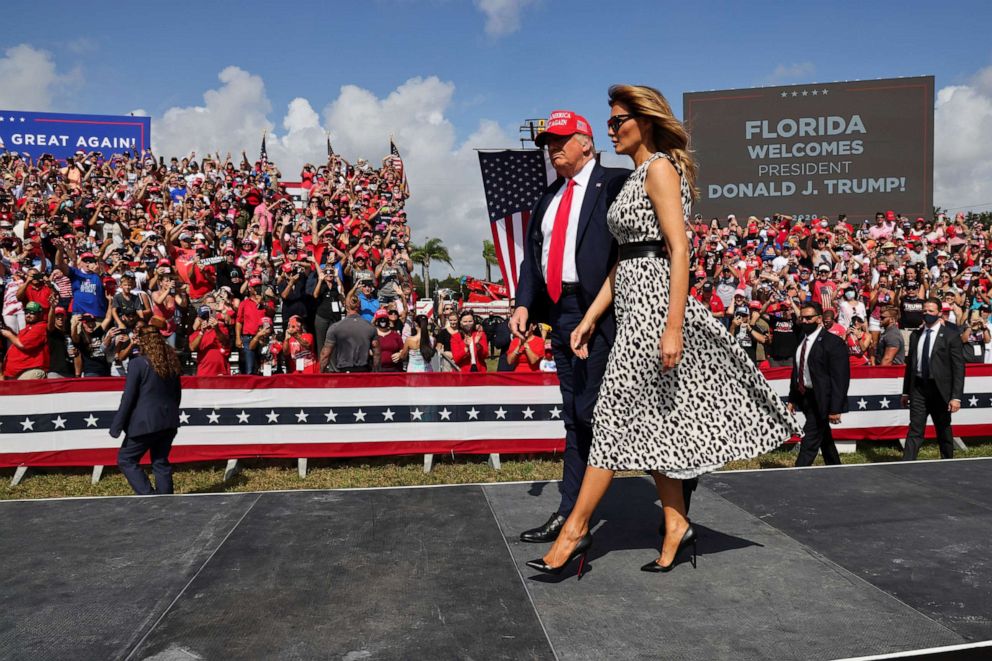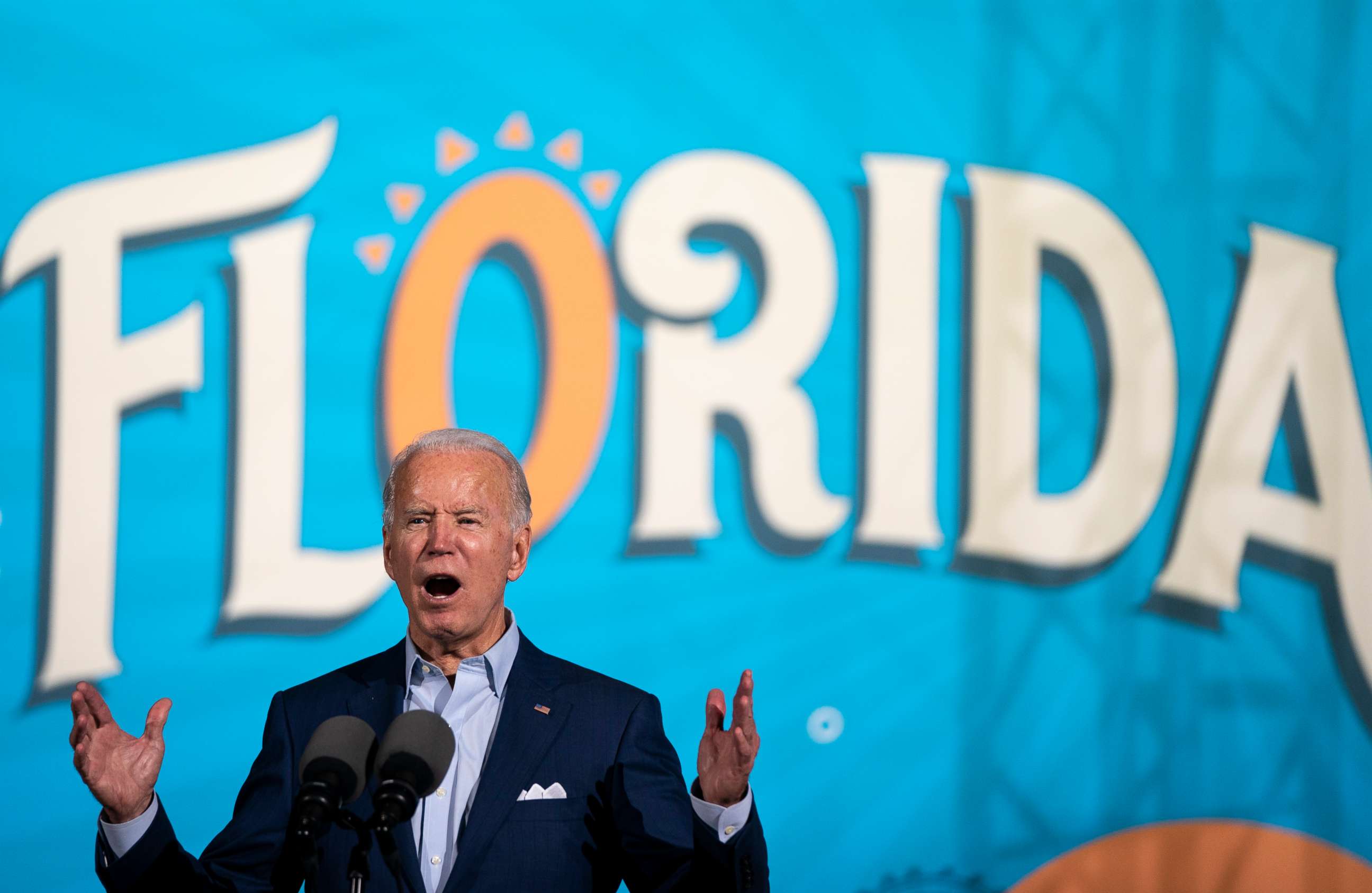Florida maintains toss-up status while Biden leads slightly in Pennsylvania: POLL
There's been little change from September in two critical swing states.
The pandemic versus the economy defines the presidential contest in two key battlegrounds, with Florida holding firm to its toss-up status while Joe Biden leads slightly in Pennsylvania in the season's final ABC News/Washington Post polls.
There's little change in either state. In Florida, Donald Trump has 50% support among likely voters to Biden's 48%; it was 51%-47% in an ABC/Post poll Sept. 20. Trump won the state by 112,911 votes out of more than 9.4 million cast in 2016.
In Pennsylvania, the race stands at 51%-44%, Biden-Trump, a 7-point advantage for the Democrat; that compares with a 9-point margin late last month. Here, Trump's 2016 win was even narrower: 44,292 votes out of nearly 6.2 million cast.
See PDF for full results, charts and tables.
Biden owes his standing in Pennsylvania to most of the same groups his campaign relies on across the country. He holds a 14-point advantage among women, compared with an even contest among men; an 18-point lead among independents, a frequent swing voter group that Trump won by 7 percentage points in the state in 2016; and a 28-point lead among moderates.
Biden is competitive among white voters in Pennsylvania -- they divide 50%-46%, Trump-Biden -- while he wins 76% support from members of racial and ethnic groups in the state. In Florida, by contrast, Trump leads among whites by 20 points. Additionally, boosted by Cuban Americans, he runs competitively among Hispanic voters.
Both states have been spared the worst of the current surge in coronavirus cases, yet these polls, produced for ABC by Langer Research Associates, show that the pandemic remains a powerful factor. In Pennsylvania, likely voters by 56%-38% say it's more important to try to control the spread of the virus than to restart the economy; this narrows to 49%-45% in Florida. In both states, Trump wins more than 8 in 10 of those who prioritize the economy, while Biden wins more than 8 in 10 of those focused on stopping the spread.

Approvals and worry
Trump just touches majority approval in Florida for his work in office overall, marking his competitiveness in the state; 51% of likely voters approve of his work in office, 48% disapprove. In Pennsylvania, he's underwater, 44%-54%. Typically for an incumbent election, these views closely reflect vote preferences.
Trump is boosted in Florida by notably positive ratings for handling the economy, 58%-40%. This works less well for him in Pennsylvania, 52%-46%. These fade to a split decision in Florida on his handling of the pandemic (48% approve, 50% disapprove) and a negative result, 41%-56%, in Pennsylvania.
Trump has urged economic reopening, and indeed Florida lifted all statewide COVID-19 restrictions a month ago. In Pennsylvania, by contrast, masks are mandatory in public places and businesses must operate at reduced capacity indoors.
The states report similar recent infection rates: 19 new daily cases per 100,000 residents in Florida and 17 in Pennsylvania. (These compare, for example, to 78 per 100,000 in Wisconsin.) That said, Pennsylvania has a higher seven-day average test-positivity rate, 13.3% versus 5.2% in Florida. And hospitalizations are up 54% in the past two weeks in Pennsylvania, compared with 7% in Florida.
Sixty-two percent of likely voters in Pennsylvania are worried that they or an immediate family member may catch the virus, and 8% say it's already happened. Fewer in Florida, 55%, are worried (and 10% say it's happened). In both states, among likely voters who are worried about catching the virus, 70% support Biden.
Trust and qualities
Preferences to handle the economy and the pandemic roughly follow Trump's approval ratings on them. In Florida, likely voters trust Trump over Biden on the economy, 55%-42%, and divide evenly in trust to handle the pandemic. In Pennsylvania, it's 48%-45%, Trump-Biden, on the economy, and switches to 51%-40%, Biden-Trump, in trust on the coronavirus.
On another issue in Pennsylvania, likely voters split evenly, 45%-45%, in trust to handle fracking in the state. In their final debate, Trump accused Biden of favoring a ban on fracking. Biden has said he would ban new oil and gas drilling on federal land, but allow continued drilling under existing federal permits and on non-federal land.

Differences between Pennsylvania and Florida also emerge in views of the candidates' personal qualities. Likely voters in Florida divide evenly between Trump and Biden on who's more honest and trustworthy (46%-45%) and who better understands the problems of people like them (47%-47%). Trump moves to an advantage as the stronger leader, 53%-44%.
In Pennsylvania, instead, Biden leads on the first two of these – 49%-39% for honesty and 51%-40% for empathy – and runs evenly with Trump on strong leadership, 47%-47%.
Voting
Among the sharpest differences between these states is how people there intend to vote. In Florida, 60% of likely voters said (in interviews last Saturday through Thursday) that they'd already voted, and 23% still intended to vote early, leaving just 17% as Election Day voters. Preferences among early voters are close, 50%-47%, Biden-Trump.
In Pennsylvania, by contrast, most, 58%, said they'd vote on Election Day, 32% said they'd already voted and the rest still intended to do so. Here self-reported early voting was far more lopsided for Biden, 75%-22%.
Regionally speaking
There are large differences across regions of both states. On its face, Biden's advantage in Pennsylvania rests on Philadelphia, with nearly a 4-1 lead, and its suburbs, 59%-36%. That said, Trump's position in central Pennsylvania, 52%-42%, is a comedown from his 28-point win there in 2016. The race is essentially tied in the northeast (including Biden's childhood hometown of Scranton), and 54%-45%, Trump-Biden -- not a significant difference given the sample size -- in the western counties, including Pittsburgh.
In Florida, Miami, the Gold Coast and the Keys -- with about 3 in 10 of the state's likely voters -- is Biden's best region by far, 60%-38%. Trump comes back with an equally large lead in northern Florida and the Panhandle, 61%-38%, and a broad 68%-30% in the central and Gulf Coast counties. The race is essentially tied in the Tampa area and a close 52%-45%, Biden-Trump, in Orlando and the central Atlantic coast.
Groups
While both candidates draw from their accustomed bases, there are some notable differences. Biden, as noted, leads among independents in Pennsylvania by 54%-36%; in Florida they split evenly, 48%-47%, Biden-Trump. (Similarly, independents in Florida are 12 points more apt than those in Pennsylvania to approve of Trump's work in office.)
Also as mentioned, Trump wins whites in Florida by 59%-39%, while in Pennsylvania they divide, 50%-46%, Trump-Biden. This includes a big difference among white Catholics; they divide evenly in Pennsylvania, while supporting Trump by 62%-37% in Florida. Further, in Florida, Trump is supported by 71% of non-college white men, about the same as four years ago. In Pennsylvania, instead, his support in this core group falls to 56%, down 15 points from 2016.

Across the political spectrum, college-educated white women in Florida back Biden by 59%-41%, an 18-point margin; Trump won them by 23 points in 2016. Biden has a 40-point lead in this group in Pennsylvania, 67%-27%. Hillary Clinton won them by 14 points.
Hispanics divide closely in Florida: 51% for Biden, 47% for Trump. While the sample is small, this is influenced by substantial support for Trump among Cuban Americans. Biden is ahead among non-Cuban Hispanics and has broad support from Black likely voters.
Among other groups, Biden wins 70% of urban likely voters in Pennsylvania versus 56% in Florida. And seniors divide 54%-45%, Trump-Biden in Florida -- not a significant difference given the sample size -- while going the other way, 57%-42%, Biden-Trump, in Pennsylvania. Compared with those in Pennsylvania, Florida seniors are 17 points more apt to prioritize restarting the economy over controlling the coronavirus, 13 points more likely to approve of Trump's handling of the economy and 9 points less worried about catching the virus.
Methodology
This ABC News/Washington Post poll was conducted by landline and cellular telephone interviews Oct. 24 to 29, 2020, among random samples of 915 Florida registered voters, including 824 likely voters; and 908 Pennsylvania registered voters, including 810 likely voters. Results have margins of sampling error of 3.5 percentage points among registered voters and 4.0 among likely voters in both states, including design effects. The vote preference question included the Libertarian candidate in Pennsylvania and the Green and Libertarian candidates in Florida. Neither was included in the September surveys in these states.
Partisan divisions – Democrats-Republicans-independents – are 31%-35%-29% among registered voters and 31%-36%-28% among likely voters in Florida and 33%-36%-26% among registered voters and 36%-36%-24% among likely voters in Pennsylvania.
The survey was produced for ABC News by Langer Research Associates, with sampling and data collection by Abt Associates of Rockville, Maryland. See details on the survey's methodology here.




